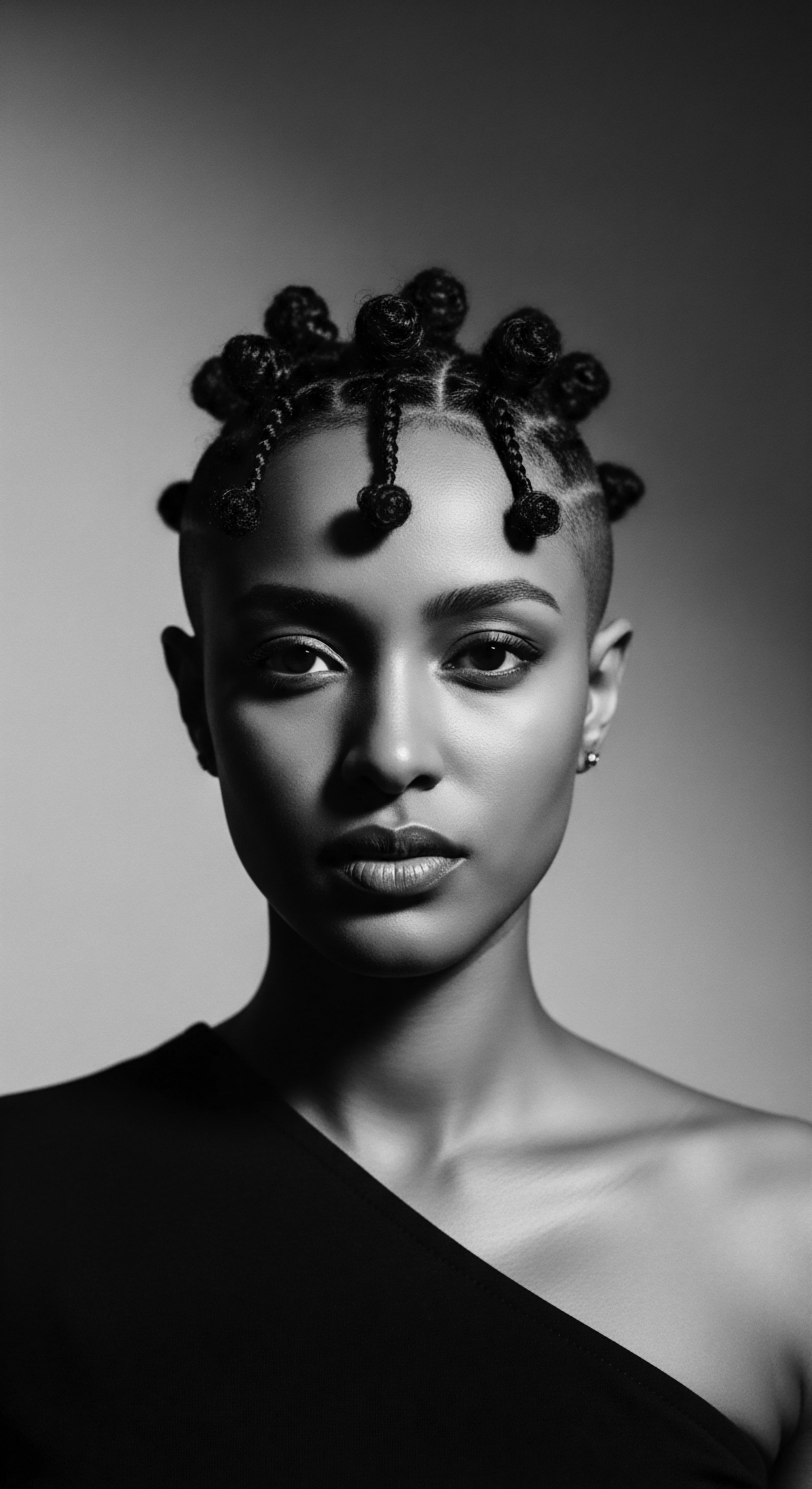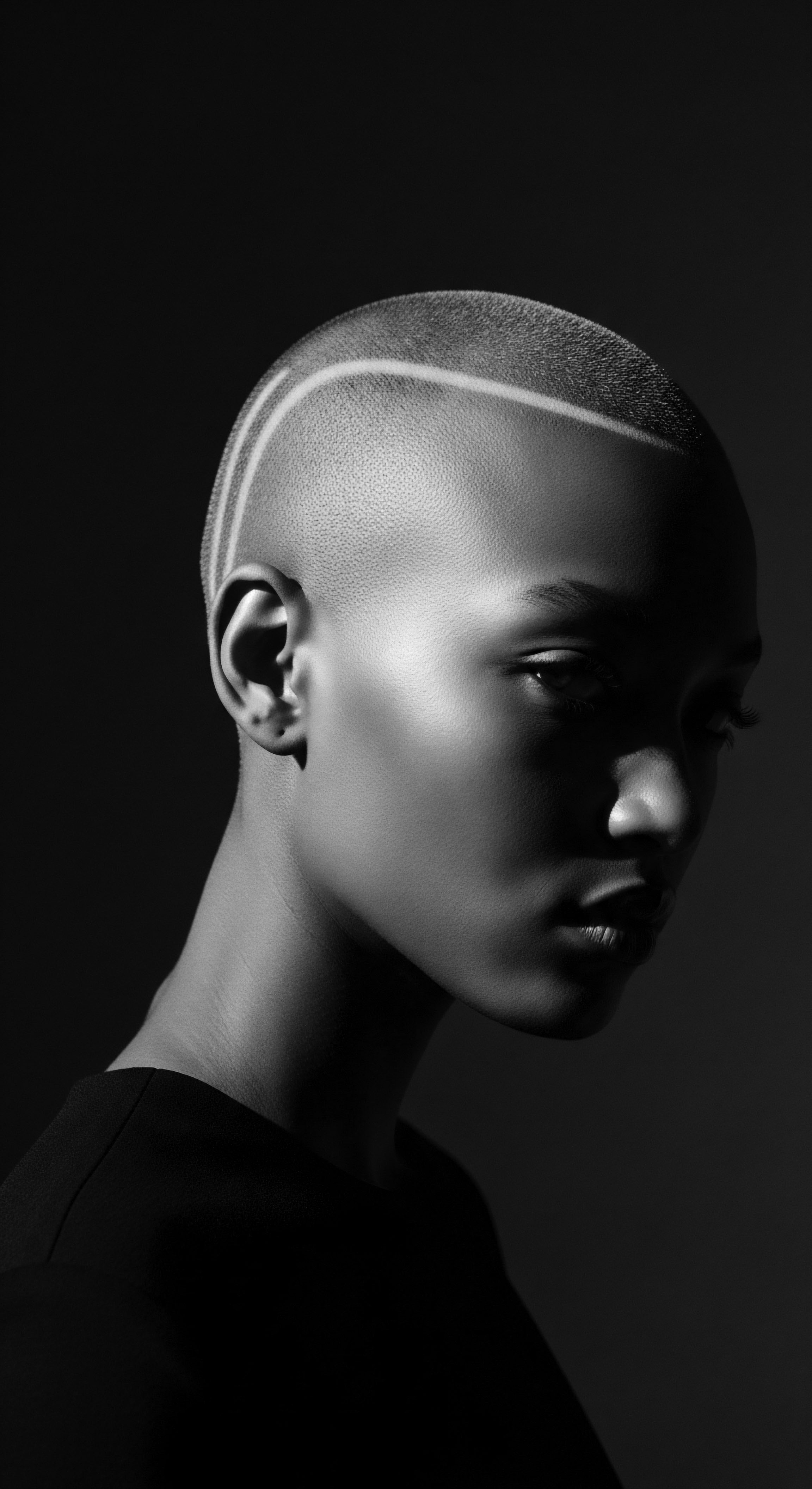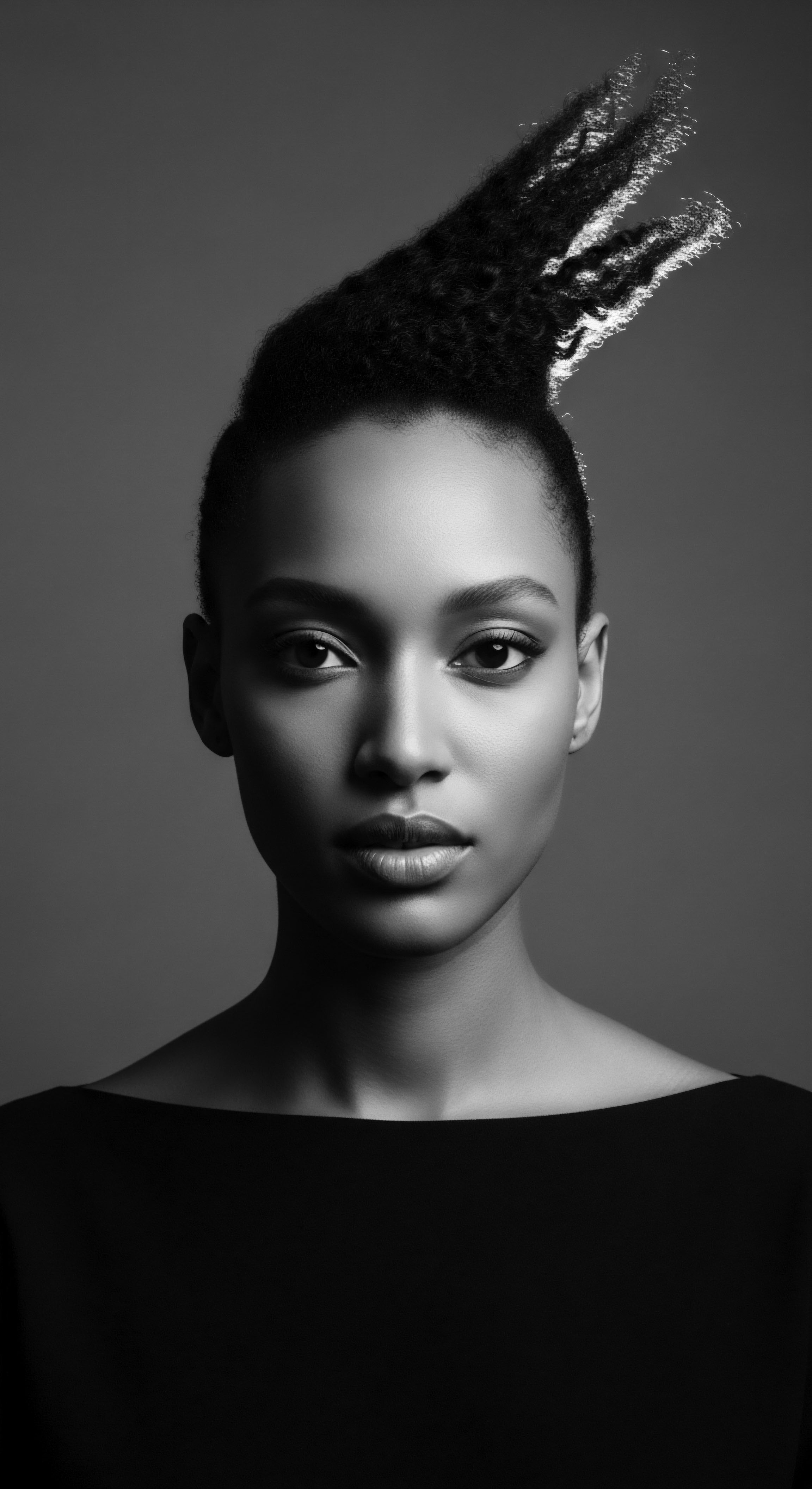
Roots
The ancestral whisper often finds its clearest voice within the strands that crown us. For those with textured hair, this whisper carries echoes of deep wisdom, a knowledge honed by sun-drenched landscapes and passed through generations. We pause to consider the very fibers of textured hair, the intricate architecture that, far from being a mere aesthetic feature, holds within it the story of a resilience against the sun’s relentless gaze.
How did the brilliant ingenuity of our forebears, living in lands where solar intensity reigned supreme, shield their hair from damage? The answer lies not only in deliberate action but in the inherent design of textured hair itself, a testament to ancestral adaptation and profound connection to the earth’s rhythms.

Hair Anatomy and Textured Heritage
The journey into understanding solar protection for textured hair begins at its very core, with the hair shaft itself. Human hair, largely composed of a protein known as Keratin, stands as a protective barrier against environmental factors. The distinct helical structure of textured hair, characterized by its tightly coiled spirals, contributes to its unique properties. This coil, a marker of profound biological heritage, often results in an elliptical cross-section of the hair strand, differing significantly from the rounder profile of straight hair types.
While the tight coiling grants a certain density, making the hair appear voluminous, it also presents a challenge for natural oils, or Sebum, to traverse the entire length of the strand. This inherent characteristic means textured hair tends to lose moisture more readily than other hair types, leading to a predisposition for dryness and brittleness if not adequately nurtured.
Within the hair’s cortex lies Melanin, the pigment responsible for its color. Melanin, a biological pigment, is a key component in hair’s natural defense system, absorbing and dissipating the sun’s ultraviolet rays. There exist two primary types of melanin ❉ Eumelanin, which imparts brown and black tones, and Pheomelanin, responsible for red and blonde hues.
Darker hair, rich in eumelanin, exhibits a higher photostability and demonstrates increased resistance to UV radiation compared to lighter hair. This biological endowment, particularly prevalent in individuals of African descent, suggests an ancestral adaptation to environments with heightened solar exposure.
The outermost layer, the Cuticle, comprises overlapping scales of keratinocytes, acting as a protective shield. It is here that the initial assaults of UV radiation are often met. Research indicates that textured hair, despite its inherent melanin, might experience more profound structural changes in its keratins when exposed to UV radiation compared to straight hair.
These alterations often manifest as changes to the hair surface, its permeability, and the organization of keratin within the strand. Therefore, understanding the intricate interplay of these anatomical features provides the foundation for appreciating how traditional African hair care practices developed as a nuanced response to environmental demands.
Traditional African hair care practices were deeply informed by the unique biological structure of textured hair, recognizing its predispositions and harnessing its natural defenses.

How Ultraviolet Radiation Changes Hair
The sun, a source of life-giving energy, also projects ultraviolet radiation, a silent force that can compromise hair health. UV radiation is categorized into UVA and UVB rays, each impacting the hair differently. UVB radiation largely affects the cuticle, inducing superficial microstructural changes and protein loss, while UVA radiation penetrates deeper, reaching the cortex and leading to color alterations. This photobiological interaction can break down the very proteins and melanin that form the hair shaft, leading to a spectrum of undesirable effects.
Prolonged exposure to the sun causes hair to become dry, diminishing its inherent strength and imparting a rough surface texture. The vibrant luminosity of hair can fade, replaced by stiffness and brittleness. This degradation occurs as UV rays stimulate the production of Free Radicals, reactive molecules that initiate a cycle of damage by breaking down lipids and proteins within the hair.
The melanin, while offering protection by absorbing UV light, also undergoes oxidative reactions, contributing to color fading or shifts in hue. This understanding of solar-induced hair alteration underscores the profound wisdom woven into ancestral practices aimed at preserving the hair’s vitality and structural integrity.
| Hair Type Textured Hair (coily, curly, kinky) |
| General Characteristics Elliptical cross-section, tight coil, higher eumelanin content, prone to dryness. |
| UV Sensitivity Note Higher inherent melanin protection, but structural predisposition to dryness and cuticle changes under UV stress. |
| Hair Type Straight Hair (fine, medium, coarse) |
| General Characteristics Rounder cross-section, smooth cuticle, oils distribute easily. |
| UV Sensitivity Note Lower melanin content in lighter shades means less natural UV absorption; cuticle more directly exposed to damage. |
| Hair Type Understanding these inherent differences guided ancestral care strategies for maximum protection and health. |
The degradation extends to the hair’s lipid content, with observed decreases in vitamin A fatty acid esters and sterol esters, further compromising the hair’s integrity. These cumulative changes manifest as increased porosity, a loss of flexibility, and a deterioration in the hair’s overall texture. The challenges posed by the sun demanded not merely superficial fixes but rather a comprehensive approach that considered the hair’s intrinsic nature and its environmental context.

Ritual
The intricate dance of hands, passed from elder to child, reveals the artistry and profound understanding behind traditional African hair care. These were not merely stylistic choices; they were elaborate rituals imbued with protective purpose, shielding the living crown from the sun’s harsh kiss. The forms of styling, often communal and deeply symbolic, served as physical barriers, historical markers, and expressions of an enduring cultural legacy, each contributing to the preservation of textured hair heritage against environmental stressors.

Protective Styling Systems
Traditional African hairstyles, rich in symbolism and history, functioned as potent shields against solar damage. Styles such as Braids, Twists, and Locs, collectively known as protective styles, minimized direct sun exposure by keeping hair gathered and close to the scalp. These elaborate coiffures, often taking hours or even days to complete, were acts of communal care and cultural expression.
They provided a physical barrier that reduced the surface area of the hair shaft directly exposed to intense UV radiation, thereby guarding against dryness, brittleness, and breakage. The ingenuity embedded in these styles allowed for extended periods of wear, reducing the need for daily manipulation that could otherwise lead to further mechanical and environmental stress.
In pre-colonial African societies, hair styles conveyed profound messages ❉ a person’s age, marital status, social rank, or even spiritual beliefs. The Yoruba people of Nigeria, for example, crafted complex hairstyles signifying their community roles. The Fulani, a West African ethnic group, are recognized for their distinct, thin, woven braids adorned with cowrie shells and beads, styles that communicated wealth, familial connections, and marital status. These styles, beyond their aesthetic appeal, embodied an understanding of hair preservation in challenging climates.
- Braids ❉ Ancient practice, dating back to 3500 BC, used for protection from heat, environmental damage, and daily styling wear.
- Locs ❉ Carried deep significance, often symbolizing spiritual connection and resistance, while physically protecting the hair shaft.
- Bantu Knots ❉ Small, coiled buns, traditionally worn by the Zulu tribes, providing a compact, sun-reducing style.

Head Wraps and Their Enduring Significance
Beyond styled hair, the practice of adorning and covering the head with fabric, often referred to as Head Wraps or scarves, served a dual purpose ❉ practical protection and powerful cultural assertion. These coverings shielded the hair and scalp from the sun’s direct rays, mitigating heat exposure and UV damage. In hot, arid climates, this physical barrier was an elemental defense against dehydration and structural compromise of the hair. Lightweight, breathable fabrics such as cotton and linen were preferred for comfort and effective shielding.
The narrative of head wraps extends into periods of profound historical challenge. During the transatlantic slave trade and its aftermath, head wraps became a means for enslaved African women to preserve their dignity and cultural identity despite brutal attempts at erasure. In the 18th century, the Tignon laws in Louisiana, for instance, mandated that free women of color cover their hair with a tignon or kerchief in public, a legislative attempt to visually denote their status.
However, these women defiantly transformed the plain head coverings into elaborate, vibrant displays of personal style and cultural pride, effectively subverting the oppressive intent and making a visible statement of resilience and beauty. This adaptation is a powerful case study in how protective practices intertwined with expressions of identity.
The act of styling hair in traditional forms or covering it with wraps transcended mere adornment; it was a sophisticated method of physical defense against the sun, interwoven with expressions of heritage and resilience.
The variety of tying techniques and the choice of vibrant patterns and colors reflected tribal affiliations, social standing, and individual creativity. Even in the face of imposed uniformity during enslavement, these head coverings maintained a strong link to ancestral traditions and a quiet form of resistance. The practice of covering hair has continued to evolve, serving as a functional choice for sun protection and a profound cultural statement in contemporary contexts. These historical practices demonstrate a sophisticated understanding of environmental adaptation, where cultural expression and physical well-being were inextricably linked.

Relay
The legacy of ancestral care practices continues its journey into contemporary understanding, providing profound insights into holistic hair wellness. Traditional African approaches to hair care, initially developed in response to environmental factors such as intense sun, offer a treasure trove of wisdom that modern science is only beginning to fully appreciate. This enduring knowledge, transmitted through generations, provides a powerful testament to the efficacy of natural ingredients and mindful routines in guarding textured hair heritage against the sun’s persistent influence.

Nourishing the Hair from Within and Without
At the heart of traditional African hair care lies a deep reverence for natural ingredients, many of which possess inherent properties that provided a shield against solar damage. These practices did not merely address superficial concerns; they aimed at nourishing the hair and scalp comprehensively, creating a resilient defense. One such remarkable ingredient is Shea Butter, extracted from the nuts of the Vitellaria paradoxa tree native to West Africa. Shea butter is rich in fatty acids, including oleic and stearic acids, which contribute to its powerful moisturizing capabilities.
These fatty acids form a protective barrier around the hair fiber, locking in moisture and helping to prevent dryness and breakage. Crucially, shea butter contains cinnamates, compounds that absorb UV rays, offering a natural form of sun protection, with some raw shea butter providing the equivalent of an SPF 6. Its vitamins A, E, and F further nourish the scalp and hair, reinforcing strength from the inside out.
Another celebrated ingredient is Baobab Oil, sourced from the ancient “Tree of Life” indigenous to the African savanna. This golden-yellow oil is replete with antioxidants, polyphenols, vitamin A, vitamin E, and omega fatty acids. These antioxidants are vital in combating the oxidative stress caused by UV radiation, effectively protecting the hair from environmental stressors.
Baobab oil also acts as an excellent conditioner, adding moisture and supporting hair elasticity, which helps hair withstand sun exposure. Similarly, Coconut Oil, a staple in many traditional hair care practices, helps to retain moisture and minimize protein loss while offering some protection against UV light exposure.
| Ingredient Shea Butter |
| Traditional Use Moisturizer, hair conditioner, scalp balm. |
| Solar Protective Mechanism UV absorption (cinnamates), moisture barrier, antioxidant vitamins. |
| Ingredient Baobab Oil |
| Traditional Use Hair and skin nourishment, scalp health. |
| Solar Protective Mechanism Antioxidants reduce oxidative damage from UV, moisturizes, improves elasticity. |
| Ingredient Coconut Oil |
| Traditional Use Deep conditioning, protein retention. |
| Solar Protective Mechanism Penetrates hair shaft to reduce protein loss, minimizes UV damage. |
| Ingredient These ancestral ingredients formed a foundational regimen for solar defense and overall hair well-being. |
The wisdom of utilizing natural ingredients like shea butter and baobab oil was a cornerstone of traditional African hair care, providing both internal nourishment and external defense against the sun.

Ancestral Wellness Philosophies for Hair Health
Beyond specific ingredients and styles, traditional African hair care was often rooted in a holistic philosophy that understood hair health as an aspect of overall well-being. This perspective acknowledged the interplay of diet, hydration, and environmental factors in maintaining vibrant hair. Regular washing and conditioning, using gentle, naturally derived cleansers and moisturizers, was a common practice. This ensured the scalp remained healthy and the hair fibers were adequately hydrated, which is a critical aspect of mitigating sun damage.
Dry hair is more susceptible to the adverse effects of solar radiation. Therefore, practices that prioritized moisture retention, such as deep conditioning treatments and sealing with natural oils, were inherently protective.
The transmission of these practices was often a communal act, particularly between women, where knowledge about specific herbs, oils, and styling techniques was shared and refined across generations. This collective wisdom created a living archive of hair care strategies, adaptable to local resources and specific environmental conditions. This collective approach not only maintained hair health but strengthened community bonds and cultural identity. The emphasis on patience and mindfulness in hair care rituals allowed for thorough application and deep absorption of beneficial ingredients, creating a robust, multifaceted defense against the sun’s drying and degrading effects.
- Moisture Retention ❉ Essential for hair resilience, preventing dryness and brittleness often worsened by sun exposure.
- Dietary Considerations ❉ Ancestral diets rich in vitamins and minerals (like A, C, E, and antioxidants) likely supported hair health and natural UV protection.
- Communal Knowledge Exchange ❉ Shared practices and oral traditions ensured the continuation and adaptation of effective hair care rituals.

Reflection
The journey through traditional African hair care practices reveals a profound and enduring connection to the sun, a relationship shaped by both challenge and ingenuity. What emerges is a heritage of adaptive wisdom, where every braid, every application of natural butter, and every head wrap was a testament to survival, beauty, and cultural identity. Textured hair, often perceived through a narrow contemporary lens, is truly a living archive, its heritage inscribed with sophisticated methods of solar defense long before modern science articulated the mechanisms of UV damage.
This exploration has highlighted not just the physical shielding against the sun’s rays but the holistic approach that wove together botanical knowledge, intricate artistry, and communal spirit. The resilience of these practices, passed down through generations, continues to guide us. The echoes from the source, the tender thread of care, and the unbound helix of identity all speak to a deep appreciation for the hair’s intrinsic nature and its ancestral lineage. Understanding this heritage allows us to connect with a powerful past, offering timeless lessons for nurturing our textured crowns in the present and for generations yet to come.

References
- Kynard, Carmen. “Wrapping Our Heads ❉ Archiving Black Women’s Style Politics.” Education, Liberation & Black Radical Traditions for the 21st Century, 2013.
- Klaudija [ebeti} et al. “UV Damage of the Hair.” Acta Dermatovenerologica Croatica, vol. 18, no. 1, 2010.
- Donkor, G.O. et al. “Antioxidant capacity and stability of ascorbic acid in fruit pulp at varying temperatures.” Journal of Food Research, vol. 3, no. 2, 2014.
- “Exploring the Use of Natural Ingredients for the Protection of Textured Hair from Ultraviolet Radiation ❉ An In Vitro Study.” MDPI, 2021.
- “Historical Perspectives on Hair Care and Common Styling Practices in Black Women.” Dermatologic Clinics, 2025.
- “Afro-textured hair.” EBSCO Research Starters, 2019.
- “The Exposome Impact on Hair Health ❉ Etiology, Pathogenesis and Clinical Features ‒ Part I.” Journal of Cosmetic Dermatology, 2023.
- “The Power of Hair in African Folklore ❉ Rituals and Traditions.” Bebrų Kosmetika, 2024.
